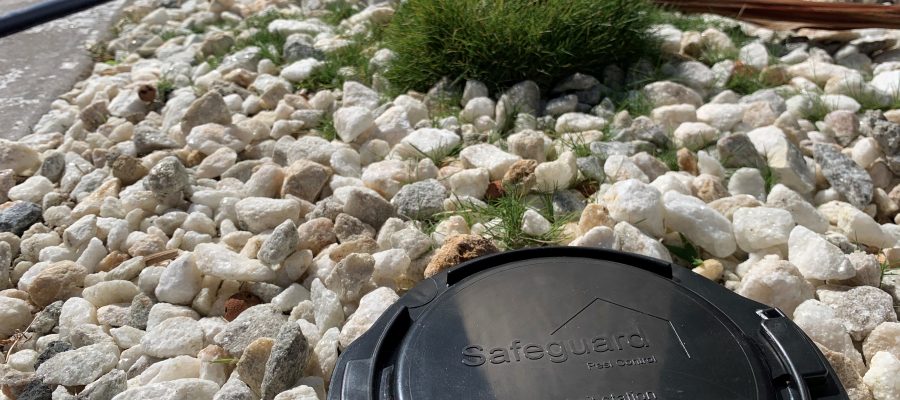Are Termite Bait Stations an Effective Pest Control Method?
- March 15, 2022
- in Pest Control
- by Ashley Dando

In Queensland, there is a 10-40% chance of facing a termite infestation in your home. Though the likelihood of infestation is dependent on the age and location of your home, it’s safe to say that termites can be a pretty serious problem.
To combat these infestations, many pest control professionals are turning to termite bait stations. But, just how effective is termite bait?
This guide will explore everything you need to know about termite baiting and how you can keep your home termite-free.
Termite bait traps are small plastic tubes implanted in narrow holes around your yard. Most pest control experts will place them roughly 1.6 meters out from the external perimeter walls
Usually, they form a perimeter around your home and are placed roughly every 3 meters. Pest control will use a special tool to drill the small holes necessary to place these bait stations.
Pest control will begin by filling these bait stations with non-toxic termite food, such as oak timber. This food will attract any existing termites, confirming their presence.
Once we’ve confirmed the termites and attracted to the bait stations, we replace the non-toxic food with a toxic bait. The termites will then carry this toxic bait back to their colonies, killing these insects at their source.
Termite bait is generally made of some form of cellulose-containing materials. This can include:
The material features a slow-acting termiticide. It’s important that this poison be slow-acting so that dying or dead termites do not accumulate around the bait stations. When dead termites accumulate, living termites are more likely to avoid the area.
Delayed poisons also help to circulate the toxin.
Advanced termite bait stations are so effective because they can kill whole termite colonies. Termites will unknowingly bring the toxic foods back to their nests in one of two ways. These include:
The poison used in bait stations also weakens the exo-skeleton of the termites, leaving them unable to molt. Without room to grow, termites are unable to reproduce. This effectively eliminates the chance of any future generations.
There are many different treatments for eliminating termite infestations. These include chemical and physical barriers around your home’s foundation.
Cost can be a consideration in choosing termite treatments. But, your property type can play a huge role in choosing a termite control method.
For example, split-level or pole-built homes will find termite bait stations to be much more effective than barrier-based treatments. Since these homes are not actually on the ground, termites can easily avoid the barriers to infesting these homes.
Termite bait stations, however, are not actually connected to any structure. This ensures the treatment goes deep within the ground to kill off any infestation.
One of the benefits of using termite bait stations is that they are 100% safe. This is especially attractive for homeowners with children or pets. Termite bait stations contain a secure cap to keep out anyone or anything, but the termites themselves.
Additionally, the termiticide used in these stations is harmless to children and animals. Basically, only insects with exoskeletons face harm from the toxin.
Overall, termite bait stations can be much more targeted than traditional barriers treatments. This makes them a much safer option.
Termite bait station installation is an ongoing process. Bait stations must be regularly inspected and services to maintain effectiveness. In many cases, customers will sign up for a specified contract, depending on the length of treatment that is necessary.
Bait station services usually include:
For a standard-sized home, one pest control technician can usually complete the initial installation in a single day.
These traps will sit in line with the ground’s surface. This means there are no ugly boxes or obstructions in your yard and traps are virtually unnoticeable.
Your pest control expert will then inspect the traps on a monthly to 4 monthly basis. These inspections are key to monitoring the activity of termites and their colonies. They also help to ensure the structural integrity of the traps.
These monthly inspections also allow your pest control expert to monitor bait levels and refill the traps if necessary.
Termite bait systems are a long-term solution to termite problems. It is not uncommon for bait traps to have 3 or 4 hits a year, all from different termite colonies.
In most cases, these termite traps can last up to 10 years. Though you may choose to end your contract, termite bait systems are a great option for those looking for a more permanent solution.
Termite bait systems can also act as “alarms,” helping you identify termite infestations before they reach the actual structure of your home. If they’re eating from the traps, it’s likely that they’ve established a nearby nest. These can be quickly found and eliminated using several different methods.
If no termite activity is found within the traps, then it is unlikely that they can or will infest your home. Termite bait systems are not only effective but also help ease your mind.
No one wants to deal with a termite infestation. They can cause untold damages to your home or business. Luckily, with termite bait, it can be easy to stop them in their tracks.
Contact Safeguard Pest Control to get started with your termite bait system installation today. We’ve helped to keep the Sunshine Coast free from pests for over 30 years. Let us help you next!